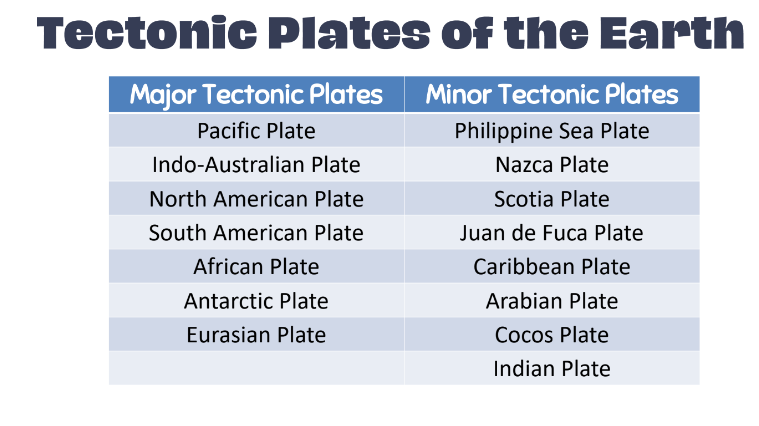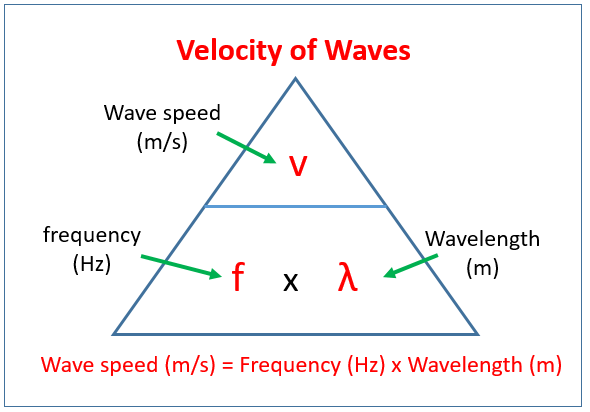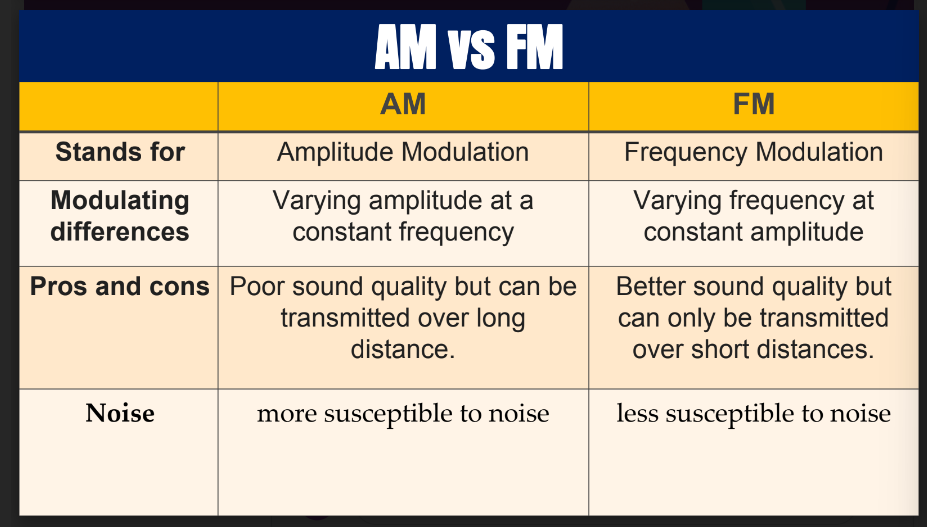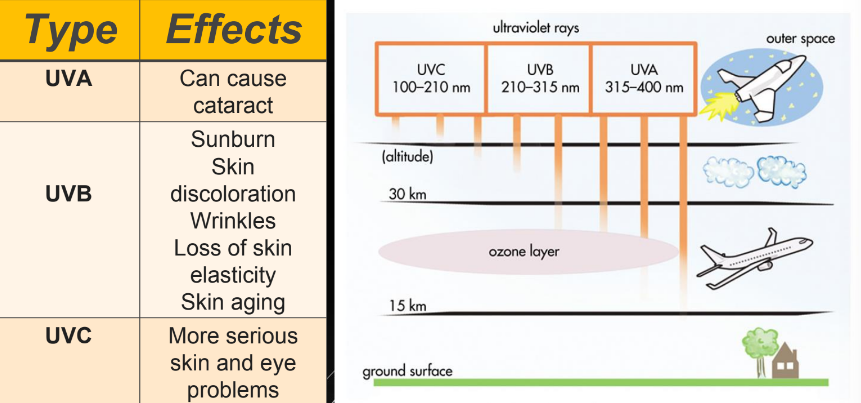SCI Q1G10
Tectonic Plates
The Earth is divided into several layers:
Compositional Layer
Crust - outermost layer of the Earth. It is the thinnest layer(7-50km). 2 types of crust:
Continental - found under continents. Reaches a thickness of up to 70 km.
Oceanic - found under ocean basins. 7 kilometers thick on average
Mantle - located beneath the Earth’s crust. Approximately 2900 kilometers thick. 2 types of mantle:
Upper mantle - rigid and contains the asthenosphere. It is a semi fluid layer that allows the movement of tectonic plates.
Lower mantle - solid lower mantle contributes to the overall convection and heat transfer in the Earth’s interior.
Core - innermost layer of the Earth. Divided into two:
outer core - a liquid layer composed of molten iron and nickel. It is about 2300 kilometers thick.
Inner core - solid central part of the Earth. Has a radius of about 1220 kilometers and is composed of solid iron and nickel
Mechanical Layer
Lithosphere-crush and upper mantle
Asthenosphere-partially molten rock. allows this layer to flow slowly
Mesosphere-material still flows but slower than the asthenosphere
core - innermost layer of the Earth
Theory of Plate Tectonics.
Alfred Wegener
theorized the supercontinent “Pangaea”(Eventually divides to upper Laurasia and lower Gondwanaland) and super ocean “Panthalassa”
The theory of plate tectonics explains the formation, movement, and changes of the rigid outer layers of Earth. It is well supported because of the continental drift theory and seafloor spreading.
Tectonic Plates
semi-rigid pieces of the Earth’s lithosphere. It floats above the asthenosphere.

Earthquakes
When tectonic plates slide past each other, the rocks along the edges experience great pressure. This pressure builds up and at some point, rocks break along a fault line releasing energy in the form of seismic waves.
Volcanism
refers to processes involved in the rise and release of magma and gases onto the Earth’s surface
Magma rises because it is less dense than the surrounding rocks
As magma is released, lava flows out and accumulates around a vent.
Volcanoes
a landform around an opening in the Earth’s surface from which lava and pyroclastic materials flow.
The Circum-Pacific Belt is a 40k km-long, horseshoe-shaped seismically active belt where 75% of the world’s active volcanoes are located and where 90% of Earthquakes occur
Hotspots
volcanoes that are not associated with plate boundaries.
Types of Volcanoes
Active volcanoes- erupted within 600-10000 years
Potentially active volcanoes-morphologically young-looking but with no record of eruption.
Inactive volcanoes - no record of eruption and are eroded and weathered.
Types of Boundaries
Divergent Boundary
plates that move away from each other.
results in the creation of new crust as magma rises from the mantle which solidifies, and forms new oceanic crust.
they are responsible for the continuous reshaping and formation of the Earth’s crust.
On land, divergent plates create rift valleys. The crust in these areas stretches and thins. This causes the land to sink and create valleys. Magma rises from the mantle leading to volcanic activity.
On water, divergent plates create ridges. This forms gaps in the boundaries which allows magma to rise up and continuously fill in the gap resulting in the seafloor spreading.
Convergent Boundaries
places where tectonic plates collide or come together.
It contributes to the formation of mountains, volcanic activity, and earthquakes.
Three types of convergent boundaries:
Oceanic Continental Convergence
The denser oceanic plate goes underneath the continental crust. This process is called subduction. During this process, trenches also form. Because of subduction, magma gets pushed out the continental plate which results in the formation of volcanic chains or volcanic arc.
Oceanic Oceanic Convergence
The denser of the 2 plates gets pushed underneath the other one. The process creates a trench. Lining the trenches are volcanoes formed under the ocean. When these volcanoes are pushed up, their summits emerge from the surface of the ocean to becomoe island. This forms an island arc.
Continental Continental Convergence
When 2 Continental plates collide, they have a tendency to rise and collide with each other because of their low density. It causes the crust to bucke, fracture, and shrink. This forms mountain ranges.
Transform Boundaries
occurs when 2 plates slide past each other horizontally. The movement along these boundaries can cause earthquakes as the plates grind against each other.
It redistributes stress and accommodates the movement between neighboring plates.
There are 3 types of faults. These are normal faults, reverse faults, and strike-slip faults.
Processes along Plate Boundaries
Earthquakes
sudden movement or shaking of the ground.
generates seismic waves which comes from the focus(the main point). The epicenter is located directly above the focus.
The shaking is caused by movements in Earth’s outermost layer(lithosphere)
Measuring Earthquakes
Magnitude
refers to the amount of energy released by an earthquake.
Intensity
refers to the severity of an earthquake in terms of its effects on the Earth’s surface and on humans and their structures.
Effects of earthquakes
1. Destruction of man-made structures
Damages to industrial facilities may contaminate the environment with toxic chemical substances.
Death due to fires, chemical poisoning, and debris.
Changes in natural landscapes such as:
>landslides
>liquefaction
>sinkholes
What to do before an earthquake?
prepare a disaster aid kit.
prepare evacuation plans.
What to do during an earthquake?
Stay calm and do not panic
Duck, cover, and hold below a strong object.
What to do after an earthquake?
beware of aftershocks, debris, holes, etc.
check for possible injuries.
listen to communication devices such as radios for updates.
Oceanic ridge systems
an area where seafloor spreading occurs.
forms because of divergent plates.
when plates move away from each other, magma rises and fills in the gap being formed.
Ridge systems are formed in oceans. On the other hand, rift systems form in the surface or on land
Volcanoes
vents in the Earth’s crust that can release pyroclastic materials such as magma, volcanic, ash, etc.
Gases
given off in large quantities during an eruption.
It is mainly made out of steam but many include sulfur dioxide, carbon dioxide, etc.
Lava
molten rocks(magma outside the crust)
reaches a temperature of 1200 degrees Celsius
may slowly fall out of the vent or be violently ejected by the volcano
Pyroclastic materials
fragments of rocks and minerals ejected by volcanoes.
Effects of volcanic eruptions:
Harmful effects:
Society and health
can cause respiratory illnesses or aggravate existing ones.
may cause headaches, rashes, etc.
communities living near volcanoes need to be evacuated.
Environment
Lava and pyroclastic materials flow to infrastructure which can damage them.
Lahar flows destroys farmlands, landscapes, and the natural environment.
Communication and Transport
ashfall can interfere with communication signals.
lava flows can destroy roads
Beneficial Effects:
changes the landscape with the formation of new mountains, hills, and plateaus.
promotes tourism
can be used for geothermal energy
ash and lava makes land fertile
lahar is good ceramic material.
Preparing for volcanic eruptions
evaluate a site for volcanic hazards.
reinforce existing buildings
have an emergency disaster plan
monitor any volcanic activity
Hotspots
areas within a tectonic plate where magma is abundant
forms many volcanoes and islands but when these plates drift away, the volcanic eruptions will gradually become less intense and eventually extinct.
volcanoes that are not associated with plate boundaries.
Mountain Ranges
formed along convergent boundaries. As they collide with one another, the crust gets deformed. They eventually form a chain of mountains or a mountain belt
For Oceanic continental, they form volcanic arcs but eventually over time, the crust gets deformed and thickens and magma loses access and it becomes a mountain belt
For continental continental, the plates collide and buckle and the plates get lifted which forms mountains.
Movement of Tectonic plates
Mantle convection or convection currents
ridge push-divergent
slab pull-continental
slab suction-continental
The main cause of the movement of tectonic plates is because of the convection currents. The other 3 are just a result of the convection currents. The movement of convection currents may be tensional or compressional.
Evidence of Plate Tectonics
Fit of the continents
the continents look like puzzle pieces.
the continental drift hypothesis proposes that the continents were assembled to form the super continent Pangaea. Eventually the plates drifted away after some time
Fossil Records
similar species were found on many continents now separated by oceans.
Geological Formation
traces of 300-million-year old ice sheet in South America, Africa, India, and Australia provided clues to their previous union with Antarctica.
Mountain belts seemed to line up with other mountain belts on different continents. They also have the same geographical makeup and age.
Seafloor Spreading
proposed by Harry Hammond Hess
the seafloor splits and moves apart. This motion constantly forms new crustal materials, usually from volcanic action. Magma from underneath the seafloor rises and fills the gap, forming a new ocean floor. New oceanic crust forms continuously at the crust of a mid-ocean ridge
ELECTROMAGNETIC WAVES
Mechanical Wave
waves that require a medium to propagate
example: sound waves and seismic waves
Electromagnetic Wave
waves that can travel in a vacuum(ex: space)
waves that can travel through matter.
waves that radiate or spread out in all directions from a source.
these waves carry energy known as radiant energy or electromagnetic radiation.
example: radio wave, microwave, infrared, etc.
>Both electric and magnetic waves are perpendicular.
>EM Waves in the electromagnetic spectrum differ in their wavelengths and frequencies.
Wavelength
the distance between two like parts of the wave.
Frequency
refers to how often something happens.
a rate quantity or number of complete vibrational cycles of a medium per a given amount of time.
expressed in Hertz(Hz).
1 Hz is equal to 1 cycle/second.
>Frequency and wavelength are inversely related. This relationship can be shown as:
c=λf or V=λf
c=3×10⁸m/s
1nm=1×10⁻⁹m

Electromagnetic Spectrum:
a collection of all types of EM waves arranged according to their wavelengths and frequencies.

Types of Electromagnetic waves:
Radio waves:
have the longest wavelength among all the electromagnetic waves.
a common application of this is a radio that picks up radio waves through an antenna and converts it to sound waves.
it can be produced by charged particles vibrating back and forth.
they are detected by antennas.
MRI - magnetic resonance imaging

Microwaves
have a shorter wavelength and higher frequency than radiowaves
used for cooking.
produced by charged particles vibrating in electrical circuits and transmitters.
they are detected by radio and television receiving antennas.
used for communication such as cellphone signals and satellite communication.
Because of its frequency, food molecules and sugar can absorb their energy making them useful for cooking.
Infrared Waves
have a shorter wavelength and higher frequency than microwaves.
waves emitted by warm bodies.
one of the application of intrared is electronic gadgets such as remote control, old model mobile phones, and laptops.
it can be produced by molecular vibrations and hot objects.
it can be detected as heat or thermal radiation and greatly absorbed by objects.
Visible Light
has a shorter wavelength and higher frequency than infrared rays.
EM waves that we can see as colors.
one example of visible light is the ones produced by the stars and other burning celestial bodies
it is produced by excited electrons in the jump between different energy levels.
Visible to the human eye and can de detected by or in photographic films.
LASER- light amplification by stimulated emission of radiation.
applications of LASER-military(marking targets and measuring speed and range), industry(cutting and welding materials, DVD player, LASER printers, scanners), and medicine(cataract removal, correcting vision, skin treatments).
Ultraviolet Rays
Earth’s atmosphere prevents most of the sun’s UV rays from reaching the Earth.
they can damage or kill cells causing sun burn or even skin cancer.
UV carry enough energy to move through clouds and penetrate the skin, this, it is possible to get sunburn even in a cloudy day.

produced by motion of electrons in an atom.
detected by or in photographic films.
used to detect forged bank notes(bills) and render visible the security marker ink in our signatures in our bankbook, air and water purifier, and investigation.
used to cure psoriasis, sterilize medical equipment, and used to harden the adhesive that dentist put on our teeth.
The electric current that flows inside the bulb heats the gas inside it and produces ultraviolet light, this light strikes the coat inside the bulb and gets absorb by it. The chemical absorbs the energy of the UV Light and
reemits it as white light.
X-rays
have a shorter wavelength, higher energy and frequency that UV.
also called Roentgen Rays.
produced by motion of electrons in an atom.
detected by special types of photographic films and fluorescent screens.
soft x-rays takes photograph of our internal body parts and it can penetrate soft substances like flesh.
Hard x-rays are more penetrating and are usually used by industries.
It can also be used in airport security checks to see the inside of the luggage.
Gamma Rays
EM waves with 10000 times the energy of visible light.
has the shortest wavelength among the EM waves.
Frequency is greater than 3×10¹⁹Hz.
Wavelength is less than 1×10⁻¹¹m.
produced by motion of charged particles in the nucles of the atom through radioactive decay.
detected by Geiger-Muller counters, ion chambers and gamma-ray spectrometers.
Gamma rays are the result from nuclear reactions.
Gamma rays can be used to treat cancer cells, sterilize medical equipment and pasteurize food, drink, and medicines.
gamma rays are produced by the hottest regions of the universe
it can cause cancer and genetic mutation but it can also destroy cancer cells in a process called Radiotherapy.
Cosmic Rays
comes from outer space
consists of highly energetic particles of protons and atomic nuclei which are very dangerous but never reach the Earth.